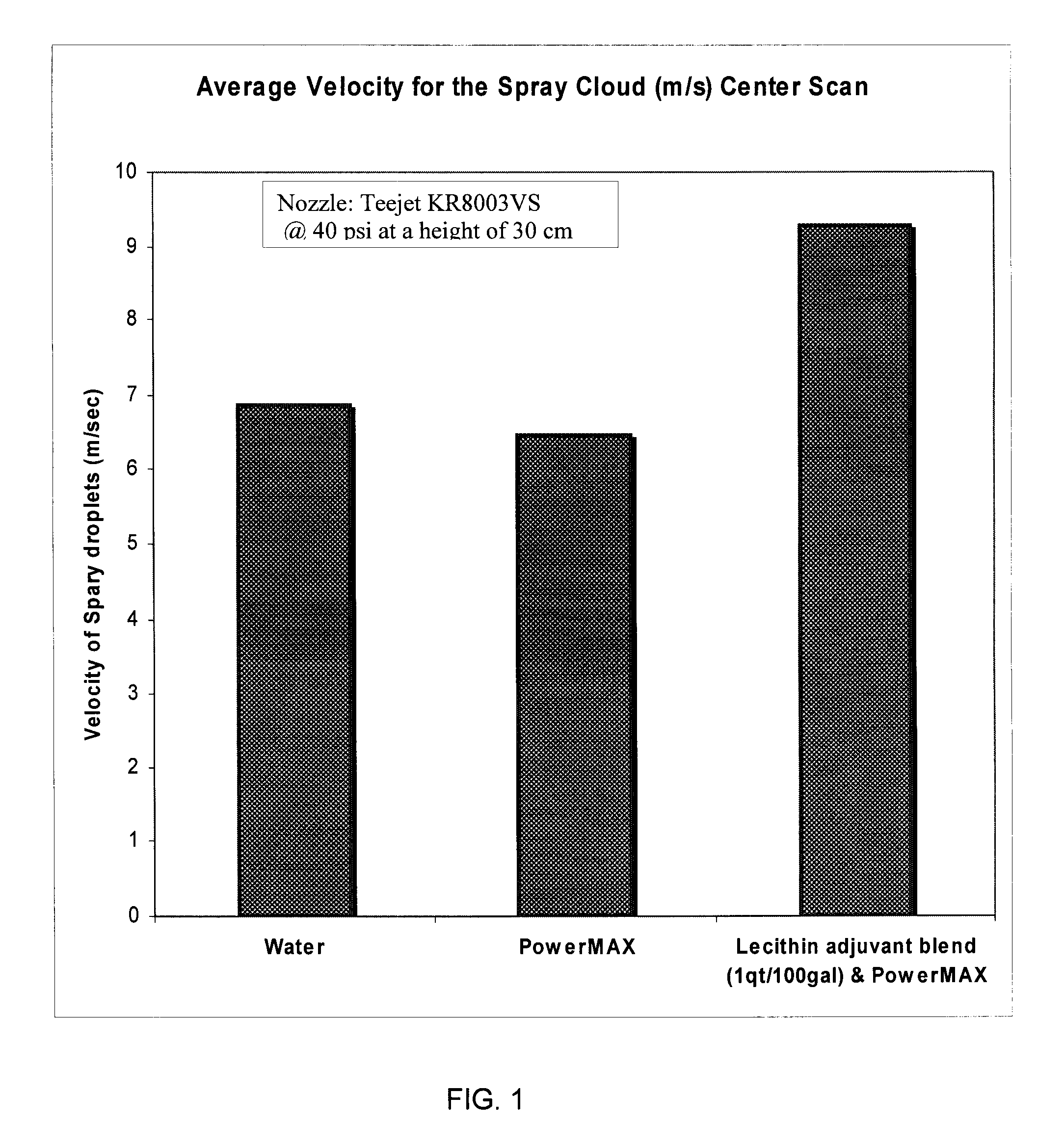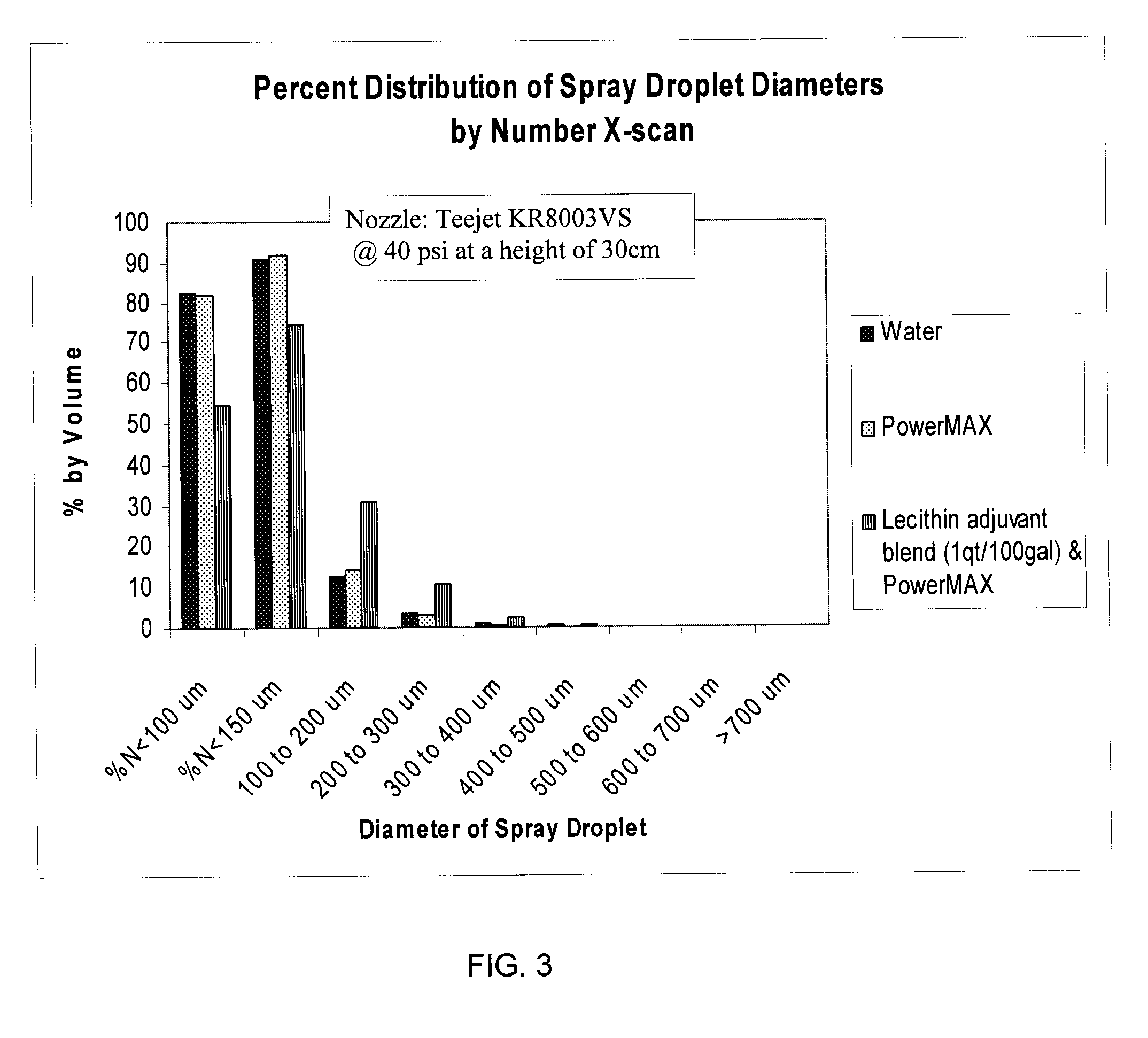Adjuvants and Methods of Using Them
a technology of adjuvants and phenol esters, applied in the field of adjuvants, can solve the problems of affecting the environment of non-phenol esters
- Summary
- Abstract
- Description
- Claims
- Application Information
AI Technical Summary
Problems solved by technology
Method used
Image
Examples
example 1
[0044]This example describes one embodiment of a method of making AN adjuvant formulation. An adjuvant blend was prepared by mixing YELKIN T brand lecithin (a crude lecithin available from Archer Daniels Midland Company, Decatur, Ill.) in an amount of 35% by weight; propionic acid (available from Fisher Scientific, Fairlawn, N.J.) in an amount of 35% by weight; vegetable fatty acids in an amount of 3.5% (available from Chemtura, Middlebury, Conn.) by weight of lecithin with fatty acid ethoxylate (Ninex MT-610 available from Stepan, Northfield, Ill.,) 10% by weight.
[0045]The ingredients were mixed and heated to 50° C. under constant stirring for between 30 minutes to 60 minutes. 20% water by weight was slowly added to the mixture with constant stirring for about one half hour. The fatty acid ethoxylate used in this example is an agricultural emulsifier and is approved by the EPA as inert ingredient under U.S. EPA §40 CFR 180.910, U.S. EPA §21 CFR 176.210, 175.105. A stable microemuls...
example 2
[0046]This example describes one embodiment of a method of making an adjuvant concentrate formulation. An adjuvant concentrate blend was prepared by mixing YELKIN SS brand lecithin (a bleached, fluidized lecithin available from Archer Daniels Midland Company, Decatur, Ill.) in an amount of 35% by weight; and fatty acid ethoxylate (Ninex MT-610 available from Stepan, Northfield, Ill.) 10% by weight.
[0047]The ingredients were mixed and heated to 50° C. under constant stirring for between 30 minutes to 60 minutes. 35% propionic acid by weight of the mixture (available from Fisher Scientific, Fairlawn, N.J.) were slowly added followed by 20% water by weight on constant stirring at 50° C. for about one half hour. The fatty acid ethoxylate used in this example is a non-APE agricultural emulsifier and is approved by the EPA as inert ingredient under U.S. EPA §40 CFR 180.910, U.S. EPA §21 CFR 176.210, 175.105. A stable microemulsion was obtained that may be used as an agricultural adjuvant....
example 3
[0048]This example describes one embodiment of a method of making an adjuvant concentrate formulation. An adjuvant concentrate blend was prepared by mixing YELKIN TS brand lecithin (fluidized lecithin available from Archer Daniels Midland Company, Decatur, Ill.) in an amount of 35% by weight; and fatty acid ethoxylate (Ninex MT-610 available from Stepan, Northfield, Ill.) 10% by weight.
[0049]The ingredients were mixed and heated to 50° C. under constant stirring for between 30 minutes to 60 minutes. 35% propionic acid (available from Fisher Scientific, Fairlawn, N.J.) by weight of the mixture were added slowly followed by 20% water by weight on constant stirring at 50° C. for about one half hour. The fatty acid ethoxylate used in this example is a non-APE agricultural emulsifier and is approved by the EPA as inert ingredient under U.S. EPA §40 CFR 180.910, U.S. EPA §21 CFR 176.210, 175.105. A stable microemulsion was obtained that may be used as an agricultural adjuvant.
PUM
| Property | Measurement | Unit |
|---|---|---|
| temperature | aaaaa | aaaaa |
| temperatures | aaaaa | aaaaa |
| contact angle | aaaaa | aaaaa |
Abstract
Description
Claims
Application Information
 Login to View More
Login to View More - R&D
- Intellectual Property
- Life Sciences
- Materials
- Tech Scout
- Unparalleled Data Quality
- Higher Quality Content
- 60% Fewer Hallucinations
Browse by: Latest US Patents, China's latest patents, Technical Efficacy Thesaurus, Application Domain, Technology Topic, Popular Technical Reports.
© 2025 PatSnap. All rights reserved.Legal|Privacy policy|Modern Slavery Act Transparency Statement|Sitemap|About US| Contact US: help@patsnap.com



